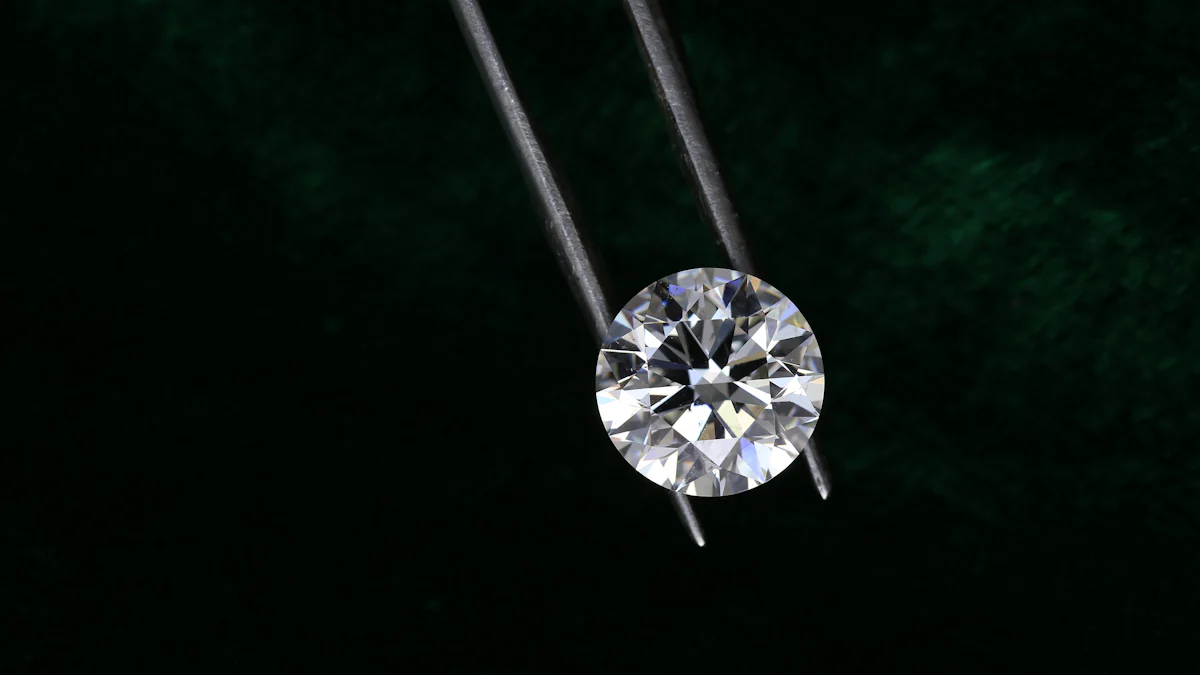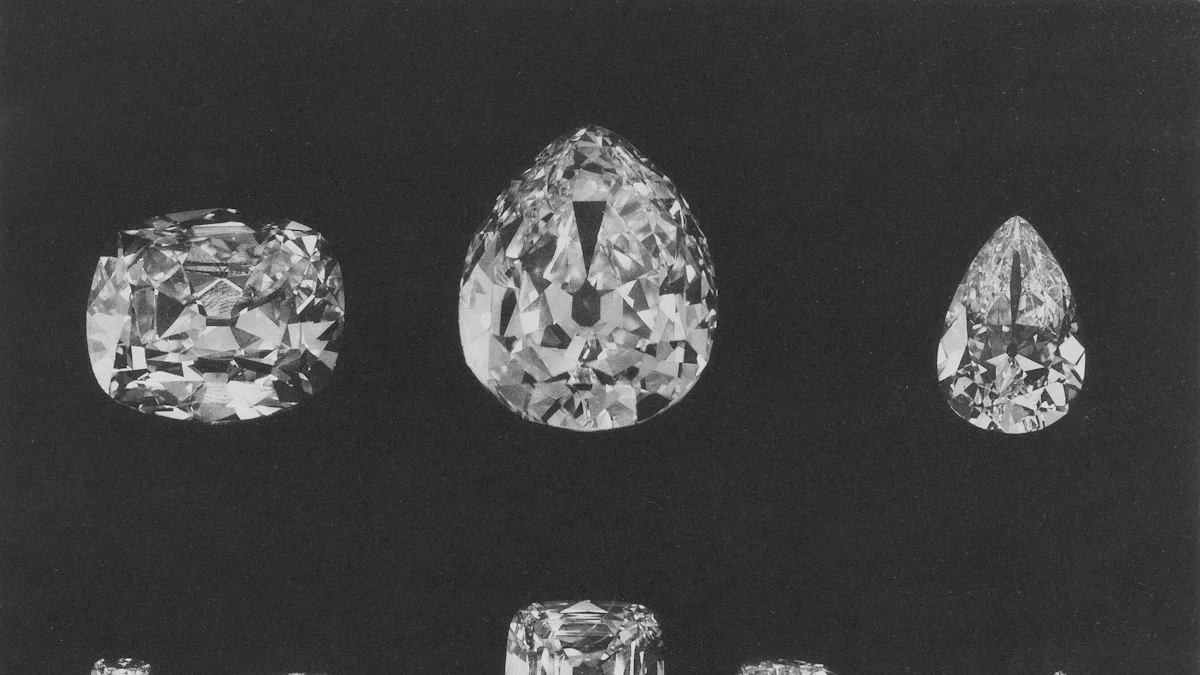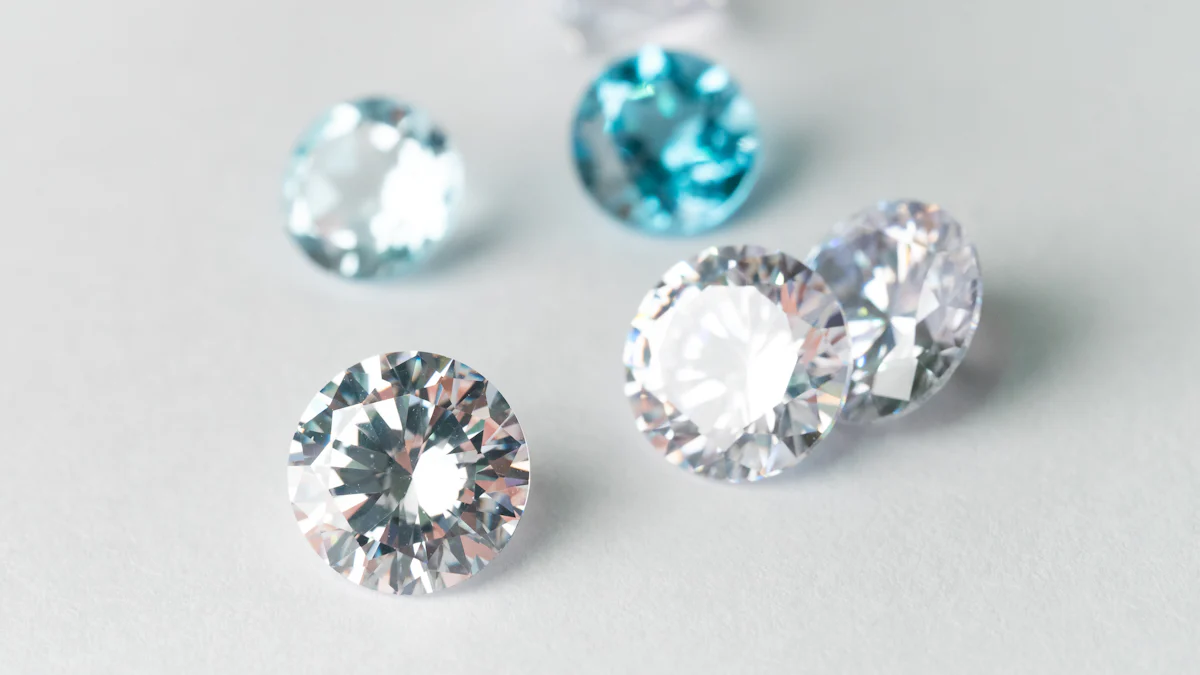What Is the Best Clarity for a Diamond?

When choosing a diamond, you want one that looks flawless to the naked eye while staying within your budget. Eye-clean diamonds, typically found in the VS1 to SI1 clarity range, provide this balance. These diamonds appear clear without visible imperfections, offering exceptional value. Clarity plays a crucial role in a diamond’s appearance, as it determines how inclusions or blemishes affect its brilliance. By focusing on eye-clean options, you can achieve a stunning diamond that combines beauty and affordability. Understanding what is the best clarity for a diamond ensures you make an informed decision.
Understanding the Best Diamond Clarity Grade

What Is Diamond Clarity?
Diamond clarity refers to the absence of imperfections, both inside and on the surface of a diamond. These imperfections, known as inclusions and blemishes, can affect how light interacts with the stone. Inclusions are internal features, such as tiny crystals or fractures, while blemishes are surface irregularities like scratches or chips. Together, these characteristics determine the clarity rating for diamonds.
The clarity of a diamond directly impacts its brilliance and sparkle. When light passes through a diamond, inclusions can obstruct its path, reducing the stone's ability to reflect light effectively. This interference can dull the diamond’s beauty and make it appear less vibrant. However, not all inclusions are visible to the naked eye, which is why understanding clarity is essential when selecting the best diamond clarity grade for your needs.
Overview of the Diamond Clarity Grade Scale
The diamond clarity scale, developed by the Gemological Institute of America (GIA), is the standard used to evaluate a diamond's clarity. This scale ranges from Flawless (FL) to Included (I), with each grade reflecting the visibility, size, and number of inclusions or blemishes. Here’s a breakdown of the main clarity grades:
- Flawless (FL): No inclusions or blemishes visible under 10x magnification. These diamonds are extremely rare and represent the highest quality.
- Internally Flawless (IF): No internal inclusions but may have minor surface blemishes.
- Very Very Slightly Included (VVS1 and VVS2): Inclusions are so small that they are difficult to detect under 10x magnification.
- Very Slightly Included (VS1 and VS2): Inclusions are minor and typically invisible to the naked eye.
- Slightly Included (SI1 and SI2): Inclusions are noticeable under magnification and may sometimes be visible without magnification.
- Included (I1, I2, and I3): Inclusions are obvious and can affect the diamond’s brilliance and durability.
The diamond clarity chart provides a visual representation of these grades, helping you understand how clarity affects a diamond’s appearance. While Flawless diamonds offer the best diamond clarity rating, they come at a premium price. For most buyers, diamonds in the VS1 to SI1 range provide an excellent balance of quality and value.
How Clarity Affects a Diamond’s Appearance
Clarity plays a significant role in determining a diamond’s overall beauty. Inclusions and blemishes can impact how light travels through the stone, affecting its brilliance, fire, and sparkle. Larger or darker inclusions, especially those located near the center of the diamond, can be more noticeable and detract from its appearance.
The size and location of inclusions also influence the best diamond clarity grade for your purchase. For example, a small inclusion near the edge of the diamond may be less visible and easier to hide with a prong setting. On the other hand, inclusions in the center can interfere with light refraction, making the diamond appear cloudy.
When choosing what is the best clarity for a diamond, consider how the stone looks to the naked eye. Eye-clean diamonds, which have no visible imperfections without magnification, often provide the best combination of beauty and affordability. The diamond clarity scale helps you identify these options, ensuring you select a stone that meets your expectations for quality and appearance.
Balancing Value and Appearance in Choosing the Best Diamond Clarity
Why Eye-Clean Diamonds Are the Best Choice
When selecting a diamond, you want one that looks flawless to the naked eye. These are known as eye-clean diamonds, and they offer the perfect balance between beauty and affordability. Inclusions or blemishes that are invisible without magnification do not affect the diamond’s brilliance or sparkle. This makes eye-clean options an excellent choice for most buyers.
Eye-clean diamonds typically fall within the VS2 to SI1 clarity grades. VS2 diamonds have minor inclusions that are difficult to detect, even under 10x magnification. SI1 diamonds, while slightly lower on the clarity scale, can still appear eye-clean depending on the specific stone. By focusing on these grades, you can maximize the value for money without compromising the diamond’s appearance.
“As long as the diamond is eye-clean, there is no need to worry about the clarity grade.” This advice from experts highlights the importance of prioritizing what you see rather than relying solely on technical grades.
Choosing an eye-clean diamond ensures you get a stunning stone that fits your budget while maintaining its visual appeal.
Best Diamond Clarity Grades for Different Budgets
Your budget plays a significant role in determining the best diamond clarity for your purchase. For those seeking premium quality, diamonds in the VVS1 or VVS2 range offer exceptional clarity with inclusions that are nearly impossible to detect, even under magnification. However, these diamonds come with a higher price tag.
If you want a balance between cost and quality, VS2 clarity diamonds are a smart choice. They provide a clean appearance without the premium cost of higher grades. For budget-conscious buyers, SI1 diamonds often deliver the best value for money. While they rank slightly lower on the clarity scale, many SI1 diamonds remain eye-clean, making them a practical and affordable option.
Here’s a quick guide to help you decide:
- High Budget: VVS1 or VVS2 for unmatched clarity and rarity.
- Mid-Range Budget: VS2 for a balance of quality and cost.
- Lower Budget: SI1 for affordability without sacrificing an eye-clean look.
By understanding these options, you can confidently choose the clarity grade that aligns with your financial goals and personal preferences.
How Diamond Size Impacts Clarity Choice
The size of a diamond significantly affects how inclusions appear. Larger diamonds, especially those over 1.5 carats, tend to reveal imperfections more easily. In these cases, opting for a higher clarity grade, such as VS2 or better, ensures the diamond maintains a clean appearance. Smaller diamonds, on the other hand, can often hide inclusions more effectively, allowing you to choose a lower clarity grade without compromising the stone’s beauty.
For example, a 2-carat diamond with an SI1 clarity grade may show visible inclusions, while a 0.5-carat diamond with the same grade might appear flawless to the naked eye. When choosing the best diamond clarity, always consider the size of the stone and how it impacts the visibility of imperfections.
To make the most of your purchase, inspect the diamond closely or consult with a professional. This ensures you select a clarity grade that complements the size of the stone while maintaining its brilliance and sparkle.
Practical Tips for Choosing the Best Diamond Clarity

Inspecting Diamonds for Clarity
When selecting a diamond, inspecting it closely ensures you make an informed choice. Look for inclusions or blemishes that might affect its appearance. Pay attention to the center of the stone, as imperfections in this area can impact brilliance. Use a jeweler’s loupe or magnification tools to examine the diamond thoroughly. This helps you identify any flaws that may not be visible to the naked eye.
Focus on finding an eye-clean diamond. These diamonds have no visible imperfections when viewed without magnification. Eye-clean stones often fall within the VS2 to SI1 clarity grades, offering excellent value and beauty. If you’re unsure about what to look for, ask the jeweler to guide you through the inspection process. Their expertise can help you spot details you might miss.
“Imperfections in diamonds graded Slightly Included (SI) are often not visible to the unaided eye, making them excellent value for money. However, the location of the inclusion is important.” — Diamond and Jewelry Specialist
This advice highlights the importance of inspecting the diamond carefully, especially if you’re considering a lower clarity grade.
Consulting Experts for Advice
Consulting a diamond expert provides valuable insights when choosing the best clarity. Experts understand how inclusions and blemishes affect a diamond’s appearance and value. They can explain the clarity grade scale and recommend options that suit your preferences and budget. Their guidance ensures you select a diamond that meets your expectations.
If you’re considering a diamond with a Slightly Included (SI) clarity grade, an expert can confirm whether it’s eye-clean. They can also help you evaluate how the size and cut of the diamond influence the visibility of imperfections. By seeking professional advice, you gain confidence in your purchase and avoid costly mistakes.
Shopping Online vs. In-Store for Diamonds
Deciding where to shop for a diamond depends on your priorities. Both online and in-store shopping offer unique advantages. Understanding these differences helps you choose the best option for your needs.
Shopping Online:
- Online retailers often provide a wider selection of diamonds at competitive prices.
- High-resolution images and videos allow you to inspect the diamond’s clarity and appearance from the comfort of your home.
- Many online stores offer detailed certificates and return policies, ensuring transparency and peace of mind.
Shopping In-Store:
- In-store shopping lets you see the diamond in person, giving you a better sense of its brilliance and clarity.
- You can consult with a jeweler directly, asking questions and receiving immediate feedback.
- Physical stores often provide personalized service, helping you find a diamond that matches your vision.
For the best results, combine both approaches. Start by researching online to explore options and compare prices. Then, visit a store to inspect the diamond in person before making your final decision. This strategy ensures you get the best clarity and value for your investment.
The best clarity for a diamond engagement ring depends on finding a balance between beauty and budget. Diamonds in the VS2 or SI1 clarity range often deliver the ideal combination of value and appearance. These diamonds typically look flawless to the naked eye without the high price of a flawless diamond. By understanding the clarity scale and focusing on eye-clean options, you can confidently select a diamond that enhances the brilliance of your perfect engagement ring. This thoughtful investment ensures your diamond offers stunning appearance and exceptional value.
FAQ
Which diamond clarity is best?
The best diamond clarity grade is Flawless (FL). These diamonds have no internal or external imperfections, even under 10x magnification. Flawless diamonds are incredibly rare and represent the highest level of quality. However, their rarity makes them significantly more expensive than other clarity grades.
What is the best diamond clarity to get?
The best clarity to get depends on your priorities. If you want a diamond that looks flawless to the naked eye without overspending, focus on clarity grades like VS1, VS2, or SI1. These diamonds often appear clean under normal viewing conditions, making them an excellent choice for balancing beauty and budget. Most people cannot distinguish between these grades and a Flawless diamond without magnification.
What is the most practical clarity grade for a diamond?
For most buyers, the VS2 or SI1 clarity grades offer the best value. These diamonds typically appear eye-clean, meaning you won’t notice any imperfections without magnification. They provide a stunning appearance at a fraction of the cost of higher clarity grades like Flawless or Internally Flawless.
How does diamond clarity affect its appearance?
Clarity impacts how light interacts with the diamond. Inclusions or blemishes can obstruct light, reducing brilliance and sparkle. However, many inclusions are so small that they don’t affect the diamond’s beauty when viewed without magnification. Choosing an eye-clean diamond ensures it looks stunning while staying within your budget.
Is a Flawless diamond worth the price?
Flawless diamonds are worth the investment if you value rarity and perfection. However, for most buyers, the difference between a Flawless diamond and an eye-clean diamond in the VS1 or VS2 range is negligible in appearance. You can save significantly by choosing a lower clarity grade without sacrificing beauty.
Can inclusions in a diamond be beneficial?
Yes, inclusions can serve as a unique “fingerprint” for your diamond. They help identify the stone and ensure its authenticity. While inclusions are often viewed as imperfections, they rarely affect the diamond’s structural integrity or overall beauty, especially in eye-clean grades.
What clarity grade should I choose for a larger diamond?
For diamonds over 1.5 carats, opt for a clarity grade of VS2 or higher. Larger diamonds tend to reveal inclusions more easily, so a higher clarity grade ensures the stone maintains a clean appearance. Smaller diamonds can often hide inclusions better, allowing for lower clarity grades like SI1.
Are SI2 diamonds a good choice?
SI2 diamonds can be a good choice if you’re on a tight budget. However, inclusions in this grade may be visible to the naked eye, depending on their size and location. Always inspect an SI2 diamond closely or consult with an expert to ensure it meets your expectations.
Should I prioritize clarity over other diamond characteristics?
Clarity is important, but it’s not the only factor to consider. Focus on the cut first, as it has the greatest impact on a diamond’s brilliance and sparkle. Once you’ve chosen a well-cut diamond, select a clarity grade that appears eye-clean. This approach ensures you get the most beautiful diamond for your investment.
Can I trust online retailers when buying a diamond?
Yes, many reputable online retailers provide high-resolution images, videos, and detailed certificates to help you evaluate a diamond’s clarity and quality. Look for retailers with strong return policies and customer reviews. If possible, combine online research with an in-store visit to inspect the diamond in person before finalizing your purchase.
See Also
Key Characteristics of an Impeccable Diamond Ring
A Guide to Diamond Cuts for Your Engagement Ring
Effective Methods for Cleaning Lab-Created Diamonds

